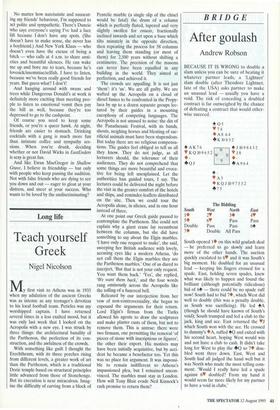Long life
Teach yourself Greek
Nigel Nicolson
My first visit to Athens was in 1935 when my adulation of the ancient Greeks was as intense as any teenager's devotion to his local football team. Pericles was my worshipped captain. I have returned several times in a less exalted mood, but it was only last week that I looked on the Acropolis with a new eye. I was struck by three things: the architectural banality of the Parthenon, the perfection of its con- struction, and the awfulness of the crowds.
With something like guilt I thought the Erechtheum, with its three porches rising from different levels, a greater work of art than the Parthenon, which is a traditional Doric temple based on structural principles little advanced from those of Stonehenge. But its execution is near miraculous. Imag- ine the difficulty of carving from a block of Pentelic marble (a single slip of the chisel would be fatal) the drum of a column which is perfectly fluted, tapered and very slightly swollen for entasis, fractionally inclined inwards and set upon a base which tilts minutely in the opposite direction, then repeating the process for 58 columns and leaving them standing (or most of them) for 2,500 years without shifting a centimetre. The precision of the masons can never have been equalled in any building in the world. They aimed at perfection, and achieved it.
The crowds are appalling. It is not just `them': it's 'us'. We are all guilty. We are wafted up the Acropolis on a cloud of diesel fumes to be confronted in the Propy- laea by up to a dozen separate groups lec- tured by their guides in a mounting cacophony of competing languages. The Acropolis is not unused to noise: the din of the Panathenaic Festival, with its bands, shouts, neighing horses and bleating of sac- rificial animals must have been stupendous. But today there are no religious compensa- tions. The guides feel obliged to tell us all they know. They do not judge, as all lecturers should, the tolerance of their audiences. They do not comprehend that some things are more beautiful and evoca- tive for being left unexplained. Let the authorities ban guided tours, I say. The lectures could be delivered the night before the visit in the greater comfort of the hotels and ships, and reminder-leaflets distributed on the site. Then we could tour the Acropolis alone, in silence, and in one hour instead of three.
At one point our Greek guide paused to contemplate the Parthenon. She could not explain why a giant crane lay recumbent between the columns, but she did have something to say about the Elgin marbles. `I have only one request to make', she said, sweeping her British audience with lovely, accusing eyes like a modern Athena, 'do not call them the Elgin marbles: they are the Parthenon marbles.' One of us dared to interject, 'But that is not your only request. You want them back."Yes', she replied, `We want them back,' and the four words rang ominously across the Acropolis like the tolling of a funereal bell.
Released by our interjection from her vow of non-controversiality, she began to expound the arguments for their return.
Lord Elgin's firman from the Turks allowed his agents to draw the sculptures and make plaster casts of them, but not to remove them. This is untrue: there were two firmans, one permitting the removal 'of pieces of stone with inscriptions or figures', the other their export. His motives may have been initially acquisitive, but by acci- dent he became a benefactor too. Yet this was no place for argument. It was impossi- ble to remain indifferent to Athena's impassioned plea, but I remained uncon- vinced. The marbles must stay in London. How will Tony Blair evade Neil Kinnock's rash promise to return them?


















































 Previous page
Previous page